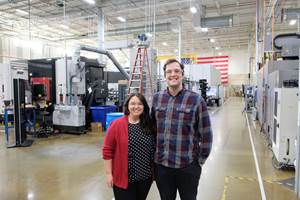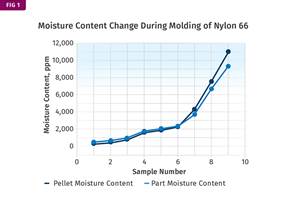PP Engineering Alloys Branch Out Into Molding, Extrusion, Thermoforming
The Hivalloy line of in-reactor grafted alloys of polypropylene and amorphous resins from Montell Polyolefins, Wilmington, Del., is expanding its market reach with new grades, new developmental alloy families, and dramatic new applications. Besides injection molding, developing applications now include thermoformed sheet and even barrier packaging films.
First unveiled in the mid-90s, Hivalloy materials are proving capable of replacing other engineering plastics--including ASA, polycarbonate, PC/ABS, PC/PBT, nylon, and acetal--in automotive, construction, marine, and consumer applications. These crystalline/amorphous hybrids boast excellent stiffness/impact balance, low density, dimensional stability, chemical resistance, and low moisture absorption. They are also readily colorable.
Processability is said to be another major feature of Hivalloy, relative to some other engineering materials. It has been commercially evaluated in injection molding (including gas-assist and two-shot overmolding processes), blow molding, extrusion (including coextrusion as a cap layer), and thermoforming
Montell's present capacity for Hivalloy is only 15 million lb/yr at Lake Charles, La., but production there can be easily doubled as demand warrants, according to Montell executives.
Glass adds muscle
Today's two commercial Hivalloy families are the G series, based on PP/PS, and the Hivalloy W series of PP/PMMA. Hivalloy G currently comprises 12 grades, including six general-purpose unfilled grades with densities of 0.90 to 0.94 g/cc and MFRs of 3 to 25 g/10 min. Within the last year or so, these have been joined by five reinforced grades containing 20-35% glass and a compound filled with 35% calcium carbonate. They have densities of 1.05 to 1.20 g/cc and 5 to 10 MFR. They are said to offer an improved stiffness/impact balance.
Application-development manager Todd Glogovsky says the new 30% glass-reinforced Hivalloy G is replacing aluminum tool boxes that are stored in the back of trucks or sport utility vehicles. Also replacing metal is a 35%-glass Hivalloy G used as a structural member of a truck bed extender. Yet another new application is electric-heated grips for motorcycles: 35% glass-reinforced Hivalloy G is the core resin, which is overmolded with an olefinic TPV elastomer.
Glass-reinforced Hivalloy W PP/acrylic alloys are also in development. Hivalloy W has advantages over the G series in weatherability and glossy appearance. There are now 11 unfilled grades with densities of 0.93 to 0.98 g/cc and MFR range of 9 to 23 g/10 min. Montell aims to develop a high-gloss, glass-reinforced compound to replace nylon in appliance handles, power-tool housings, and exterior auto trim. Product manager Holly Wilson says test samples of 15% glass-reinforced Hivalloy W have a density of 1.02 g/cc, flexural modulus of 522,000 psi, notched Izod impact of 1.6 ft-lb/in., and tensile strength of 10,500 psi. For comparison, a 14% glass-reinforced nylon 6 has a density of 1.23, modulus of 400,000 psi, notched Izod of 1.0 ft-lb/in., and tensile strength of 12,000 psi.
There is already one commercial application for Hivalloy W with a very low glass content (10%) in an indoor/outdoor chair that has hollowed-out legs molded by gas-assist injection.
Looking good longer
Automotive is one of Hivalloy's primary target markets. It is used or in evaluation for several interior and exterior applications, including "A" and "B" pillar posts, truck fenders, cowl-vent grilles, fasteners, mirror housings, wheel covers, bumper beams, instrument-panel trim, seatbelt components, glove-box doors, steering-wheel covers, and knee bolsters. Today, Montell's major focus is on mirror housings and exterior structural parts with molded-in color instead of paint. Success there depend on good surface appearance, weatherability, and scratch and mar resistance. Initial formulations were not up to automotive standards, Glogovsky concedes. But he says recent product modifications, chiefly through the use of additives, have produced more durable aesthetics while reducing CLTE. Montell has documented the improvements using Ford and Chrysler versions of crock meter instruments that simulate real life scratching and marring conditions.
Hivalloy is now in trials for non-automotive applications such as children's ski helmets, where initial feedback indicates that scratch and mar performance is adequate to replace polycarbonate. Montell also aims to replace golf carts made of painted materials such as ABS with Hivalloy W molded in color.
One new grade, Hivalloy W 5317, replaces painted metal in the skirt of the new John Deere tractors that debuted last month. This grade will become Montell's new automotive standard. Another new grade, Hivalloy W 011MR, forms the whole hood of new Kubota riding tractors. The material is said to be more weatherable and cost-effective than painted PPO/nylon.
Another focus of application development will be large thermoformed parts. Here, Hivalloy W will serve as a weatherable cap layer over Montell's high-melt-strength branched PP or a TPV.
Turning up the heat
Montell is evaluating two new developmental grafted alloys that are designed for higher stiffness and heat resistance. One family is PP/SMA (styrene maleic anhydride). The other is PP/PMMA-co-MAA (PP with a copolymer of PMMA and methacrylic acid). They have low densities (around 0.98 g/cc) and are said to be easily processed. HDT of impact-modified PP/SMA is 230 F at 66 psi and 140 F at 264 psi. For impact modified PP/PMMA-co-MAA, HDTs are 235 F and 155 F, respectively. These alloys are being field tested in automotive and other markets. Wilson says one customer is excited about PP/SMA in an appliance application. PP/PMMA-co-MAA with molded-in color is being sampled for auto instrument panels to replace painted PC/ABS or filled PP.
Barrier film of PP/PMMA-co-MAA is also being aimed at the OPP film market. The new terpolymer is said to have four times higher gas barrier than conventional OPP. While not equaling the barrier performance of EVOH, it appears to provide medium-barrier properties required for applications such as meat packaging, where it can replace PVC or PP coextrusions. It could also give higher moisture barrier than PS to packages such as creamers.
Related Content
Scaling Up Sustainable Solutions for Fiber Reinforced Composite Materials
Oak Ridge National Laboratory's Sustainable Manufacturing Technologies Group helps industrial partners tackle the sustainability challenges presented by fiber-reinforced composite materials.
Read MoreICIS Launches: Ask ICIS Generative AI Commodities Assistant
Said to be the first of its kind, this AI assistant will enhance access to ICIS’ intelligence and insights for the energy and chemical markets.
Read MoreWhat's the Allowable Moisture Content in Nylons? It Depends: Part 2
Operating within guidelines from material suppliers can produce levels of polymer degradation. Get around it with better control over either the temperature of the melt or the barrel residence time.
Read MorePolymer Showdown — PC/ABS vs. PC/PBT — May the Best Material Win
First in a series, experts from plastics engineering consultancy The Madison Group will pit leading thermoplastics against each other to see how they differ in processing characteristics, chemical resistance, thermal and mechanical performance, and more.
Read MoreRead Next
Making the Circular Economy a Reality
Driven by brand owner demands and new worldwide legislation, the entire supply chain is working toward the shift to circularity, with some evidence the circular economy has already begun.
Read MoreSee Recyclers Close the Loop on Trade Show Production Scrap at NPE2024
A collaboration between show organizer PLASTICS, recycler CPR and size reduction experts WEIMA and Conair recovered and recycled all production scrap at NPE2024.
Read More










